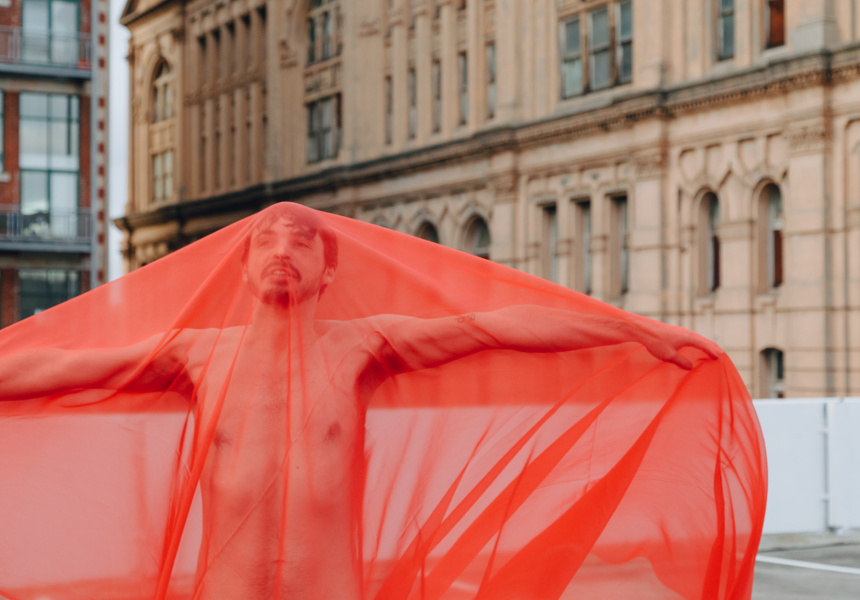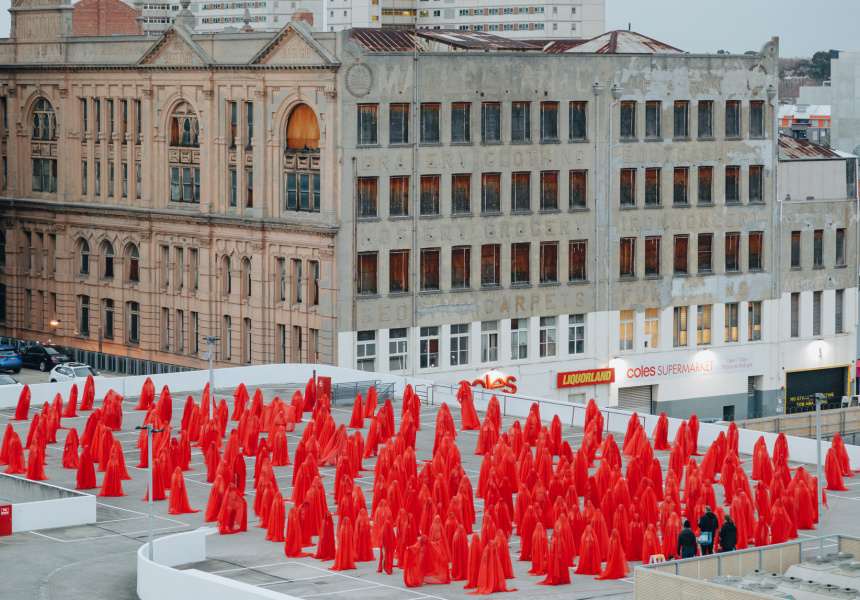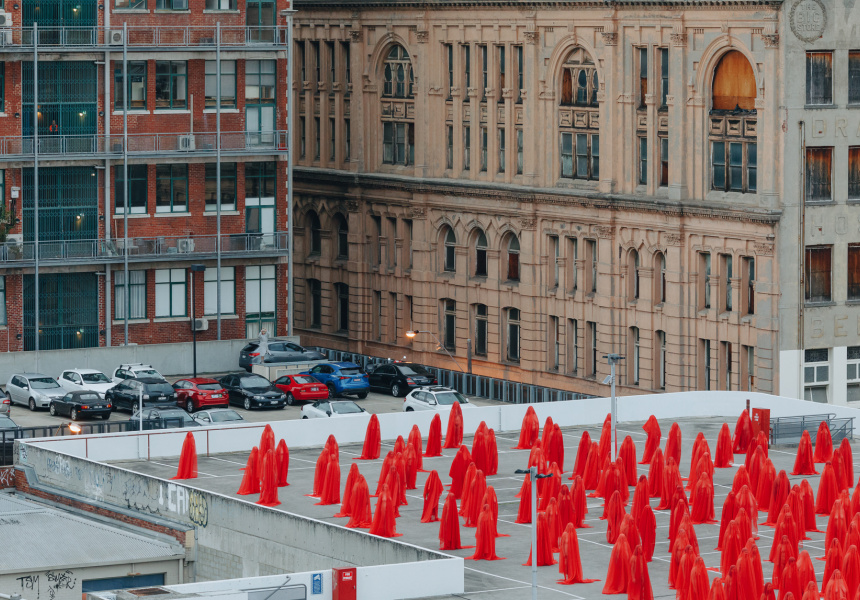It’s dawn in Melbourne. The rooftop car park of Woolworths in Prahran is a little busier than usual for this time on a Monday morning. Three hundred and fifty people are assembled, naked but for transparent red veils. The Bureau of Meteorology says it’s 10 degrees, helpfully adding it feels like eight. The wind whips under the veil and hits me where it stings.
American photographer Spencer Tunick, the reason we’re here, is standing on a stepladder, camera in hand. “This guy’s having trouble with his veil!” he yells, pointing into the crowd. “No, that guy! Get in there!”
Tunick shouts and barks orders. Over the years he’s endured legal battles and months of logistics to set up a single shot. This installation came with its own challenges. When the shoot comes, he works quickly and doesn’t waste time being polite.
We think you might like Access. For $12 a month, join our membership program to stay in the know.
SIGN UPWe’re some of the lucky 923 (from 12,500 applicants) who were selected to take part in Tunick’s two-day shoot for Return of the Nude, part of the 2018 Provocaré arts festival. Admittedly “luck” doesn’t feel like the right word when you’re lying naked on concrete on a chilly July morning. But most of us are undaunted by the cold.
When I’m not staring stony-faced for Tunick, I look around at the crowd. Any suspicion that some people might be doing this for a bit of a perv is dispelled. There’s nothing sexual or creepy about nudity in this context. This is an equal space, and different bodies presented this way are interesting, beautiful. The red shrouds nullify our identities, flatten our uniqueness. That, and it’s cold, and we’re being yelled at, and the PR assistant is standing a few feet away from me, fully clothed, texting.
An hour earlier, across the street from Woolworths, the Emerson nightclub fills with people and nervous energy. All ages and genders are represented. Some have come in groups or pairs, and many more are alone. A friend of mine had said she’d only ever do something like this if she went solo, and I wonder if many others had the same caveat. Perhaps their friends just missed the cut?
One man, who speaks to me on condition of anonymity, says he’s here because he wanted to do something memorable. Another – a short older bloke in a floppy hat who introduces himself as David (“but everyone calls me Bottles”) – wanted to be involved last time Tunick was in Melbourne, in 2001 but he had a busted ankle. He also applied for the Sydney Opera House shoot in 2010, but didn’t get picked. He’s happy he’s finally here. “I’m going to be part of art history,” he says.
Tunick’s famous large-scale nude shoots, sometimes featuring thousands of participants, have taken place in locations ranging from the Aletsch Glacier in Switzerland to Grand Central Station in New York. The now-decades-long project began for Tunick in 1990s New York, inspired by the performance-led works of artists such Yayoi Kusama and Carolee Schneemann. In 2001 he photographed 4500 naked people on the banks of the Yarra River, down St Kilda Road and in Alexandra Gardens for his installation The Unfamiliar Familiar.
“It’s been on my bucket list a long time,” says a woman called Daniela, who’s here with her daughter Olivia. “I like the idea that we’re all equal in nudity.”
Olivia, in her early twenties, is taking part because her mum wanted her to, “but also because I get really frustrated about the sexualisation of young women’s bodies,” she says. “If I show skin it’s sexual.” For Olivia, this is a different expression.
At around 7am Tunick’s team of New York assistants begins proceedings. Instructions on where to stand, when to depart and when to get naked blare out of their megaphones. Then comes Tunick himself. There’s not an ounce of rockstar-artist vibe to him. He’s a grey-haired 51-year-old in a black hoodie. He looks a little tired, and a little stressed. The crowd cheers as he stands on a chair.
“Today we’re going to be making some works,” he announces. “It’s extremely cold.” The crowd erupts with laughter, and more cheers, but he is deadly serious. “So I’ll be working as quick as possible.” He points to someone pointing an iPhone at him. “Please don’t film me,” he says.
Then he lays some ground rules. We are to do what he says. We are not to get too put out when he yells a bit. We are not to smile during the shoot. “That looks a little weird. So smile internally.” We are to take off hair ties, jewellery and glasses.
We’re all issued with red veils, and Tunick demonstrates how to wear them. A wave of “oohs” passes through the crowd as he drapes himself in the shroud.
Then we head to the rooftop.
-
-
- *
-
A few days earlier I sat down for lunch with Tunick and asked over antipasto: Why naked bodies?
“I enjoy how the nude is a lightning bolt in public space,” he told me. “It creates a confrontation between nature and the concrete world.”
When he was younger, before he studied photography, Tunick would walk home from parties at dawn through the streets of Boston. “No cars, no people, just me and this apocalyptic sunrise,” he recalls. “The street was like a canvas.”
Spencer Tunick’s medium is people, which often causes problems. Most difficulties stem from the fact he creates work en plein air and au natural. That is, he shoots masses of nude people, often in urban environments.
To get the Melbourne shoot on track, for example, was a battle. Tunick wanted the Woolworths space because it’s high up, has a spectacular view, and is free from the overhead tram wires that hem in most of our streets. Woolworths denied his request to use the car park in June – after Provocare had already announced the site as one of the shoot locations – saying it would present an inconvenience to its customers. The supermarket reversed course later that month after a public outcry. But Tunick was forced to shoot at dawn, and on a Monday instead of a weekend.
“It’s very depressing,” he says. “I sent Woolworths a letter trying to push it later in the day so it’s a little more comfortable for people. There’s a big difference in 10 degrees.”
When he started photographing nudes, in public, in New York in the early ’90s, things were simpler. Tunick gets his phone out and shows me his first public nude image, a black-and-white photograph called Heather with Swordfish on 5th Ave. It shows a naked blond woman standing on an empty sidewalk holding a huge swordfish aloft. There are a few cars in the background, but it’s otherwise quiet.
“There were no cameras, no security, no concrete cinder blocks everywhere,” he remembers. “It was less crowded, a little grittier. Amazing.”
As his profile emerged, so did problems. He ran into issues with law enforcement during the years when Rudy Giuliani was mayor of New York City. He was arrested five times, including in 1999 during an installation in Times Square.
Now, almost two decades later, Tunick is an expert on different cities’ public indecency laws.
-
-
- *
-
Back on the rooftop, Tunick is shouting again, trying to arrange the crowd evenly across the grey concrete. “It’s like colouring in,” he yells. “You need to fill up the space!”
An assistant runs past to make sure the man beside me has his feet covered by the veil, saying under her breath, “He’s gonna yell at me he’s gonna yell at me he’s gonna yell at me.” She’s out of there in a flash, and he doesn’t.
Tunick isn’t the only photographer here. The media are standing about 20 metres away, taking shots of my arse that will later end up in the Guardian, ABC and CNN, days before this article.
We stand with arms outstretched, draped in our veils. We hold them behind us like capes. We lay atop them on the freezing concrete, and then under them, so we’re a sea of blood-red bodies. The sky hangs grey over our heads. A groan and a laugh comes over the crowd as we’re lying there and spot a drone camera overhead (nothing to do with Tunick or the media), close enough that we can hear it whir. There’s a 50 per cent chance of rain, but it never comes. Then we’re done.
“Thank you! Please take some nude self portraits,” shouts Tunick to the crowd as we scramble back to our thermals. “But pixelate them or you’ll get kicked off social media.”
It was a nice few minutes of communal vulnerability, captured forever. A lightning bolt caught in a camera.
Spencer Tunick’s work can be bought at nakedpavementbooks.com



